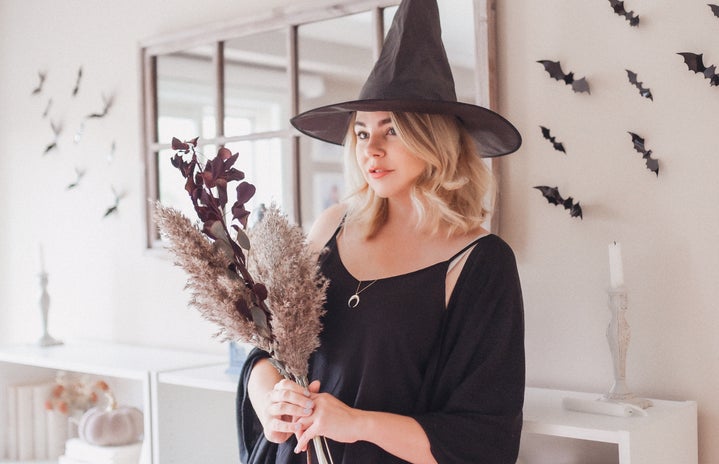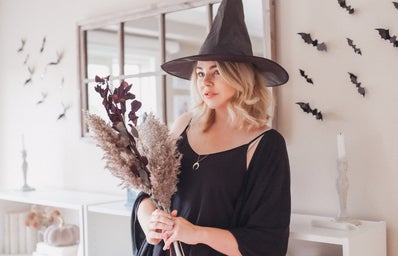Finally it is october and Halloween is coming! Celebrated on October 31, the date is very well known in the United States and some other countries in North America as the night that children wear costumes to ask for trick or treat. It came from the term “All Halllows’ Eve”, or literally the night before the All Hallows day. But the origin of this celebration is derived by a pagan one: the Samhain, that honors the end of the summer and the abundance of food after the harvest time.
Here in Brazil, this celebration is called “Witches day”, or in portuguese “Dia das Bruxas”. But have you ever thought about who are the women called witches? Why has the word witch been being used as an offense for some and as a symbol of resistance for others nowadays? To answer these questions we’ve talked to the Wiccan Priestess Jenni and Vanessa Beatriz Bortulucce, professor at the Brazilian Museum of Sacred Art, Cásper Líbero University and Centro Universitário Assunção (UNIFAI). Check it out!
- Who were the witches?
-
First of all, we need to search the etymology of the words Witchcraft and Witchery. According to Wikipedia, they’re related to the term wisdom, so we can come to the conclusion that the people who have the knowledge about these practices are very wise.
“Witches are women that had ancient knowledge, much older than the catolicism (…) This knowledge is polytheistic and, a great part of them, prehistoric; because the first bonds our ancestors had made were with the forces of nature, that after were personalized as gods in the pantheons”, explains Vanessa.
Besides the singular connection with earth resources, Jenni also highlights that a witch is someone that learns with older generations. These women used to heal things using the elements of nature, had a large knowledge about ancient chants to bring prosperity and good things to the lands, herbs, teas, crystals and some other things that could help with physical and spiritual illnesses.
But this knowledge was a way very dangerous to christians, as the religion was fortifying its domain in a majoritary pagan territory. “The christianity was afraid that people would worship elements of nature, so it persecuted people who worshiped those elements, who made a very personal interpretation of religion and used hybrids between Catholic and pagan practices”, said Vanessa, explaining by these way how the witchcraft was related to bad and malefic things.
This period described by the teacher is known as the Inquisition, which created the stigma that has persisted for so many years and is still present in some parts of the population that don’t have information about it or treat the matter as a tabu. Also, this stereotype affects more women than men.
- Witchcraft and the feminine
-
“We call women witches when they bother us in some way”. This phrase from Vanessa couldn’t be better to open this section of the article. The women were the most affected for the demonization of the Witchcraft, because they were supposedly more inclined to go the wrong way. “This is a vision drown in the Judeo-Christian culture, in which the women are saw as the sex who is not trustfull. Is like all of the women were marked by Eve’s mistake, by this way using our beauty and our sexuality to distort and afast men from God”, she concludes.
Another important point to stand out is that the women were always considered more connected to nature because both have their cycles. This was used to explain how they were supposedly more likely to “fall into temptation” in some moments of their lives, such as when they were teenagers or in their periods. Men, however, as witchers or mages were in fact considered wise and good advisers. According to Vanessa, while the male group is seen with good eyes, witches were always the figures that would not do anything good.
Because of this persecution, the women that really practiced witchcraft or believed in pagan deities, had to create strategies to continue practicing their faith such as a new alphabet. “The information was also passed through a proper alphabet to leave the spells and magic there without people discovering them”, told Jenni.
Nowadays, the witches are a symbol of resistance and strength, also being related to self-knowledge and self-acceptance.
- The modern witches
-
Vanessa says that we have two big stereotypes derived from the medieval images for witches: one is ugly and old, the other is beautiful and sexy, but this beauty is fake, turning the women’s sexuality into a threat.
The women that call themselves witches nowadays don’t use this term as the stereotype. “They are witches in the sense of making a reconnection with nature because people are saturated by the industrial and post-modern experience, that is mainly racional. So they are looking for spiritual questions and a more sustainable culture”, explains Vanessa.
People are looking for natural therapies and even to learn more about the food or flowers therapeutic properties, to chase for homemade cures. Jenni reinforces this point by saying that “modern witchcraft is very much about self-healing, even in holistic therapy, that it brings elements such as essential oils, flowers, crystals, used for self-healing. (…) Modern witches are the women who dedicate themselves to study those things.”
Jenni also says that some of the stereotypes maintained by those women, like the hats, the wands or black clothes, are not something bad, because they maintain a tradition, but are becoming commercial things. “They say that you must have a whole apparatus, when you really just need to believe with your heart and make your wishes and prayers with your soul.”
Nowadays the image of the witches is also frequently associated with feminism, because they show a strong mark of resistance, also representing the sexual freedom of the woman and the assumption of their desires.
“There is also the question of self-knowledge, the various types of body and the different types of beauty. I think there is this whole issue of veganism, natural births, women accepting themselves more, this made them look at the question of the witch, this woman who knows nature as she knows herself.”, defines Vanessa.
Jenni also brings up an important standard from Wicca that can be the thing people should have in mind when thinking about witches and wiccans: they are women that believe in the precept “Do as your will, if it doesn’t harm anyone”.
—————————————————————–
The article above was edited by Gabriela Sartorato.
Liked this type of content? Check Her Campus Casper Libero home page for more!


